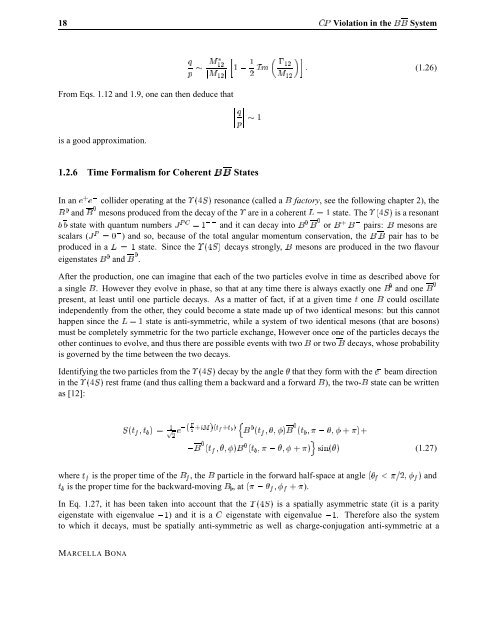Violation in Mixing
Violation in Mixing
Violation in Mixing
Create successful ePaper yourself
Turn your PDF publications into a flip-book with our unique Google optimized e-Paper software.
18 �È <strong>Violation</strong> <strong>in</strong> the �� System<br />
From Eqs. 1.12 and 1.9, one can then deduce that<br />
is a good approximation.<br />
Õ<br />
Ô<br />
Å £ � �<br />
� ÁÑ<br />
�Š�<br />
Å<br />
¬<br />
¬<br />
¬ Õ<br />
Ô¬<br />
�<br />
1.2.6 Time Formalism for Coherent �� States<br />
�� � (1.26)<br />
In an � � collider operat<strong>in</strong>g at the § �Ë resonance (called a � factory, see the follow<strong>in</strong>g chapter 2), the<br />
� and � mesons produced from the decay of the § are <strong>in</strong> a coherent Ä � state. The § �Ë is a resonant<br />
� � state with quantum numbers  � � and it can decay <strong>in</strong>to � � or � � pairs: � mesons are<br />
scalars (Â È � ) and so, because of the total angular momentum conservation, the � � pair has to be<br />
produced <strong>in</strong> a Ä � state. S<strong>in</strong>ce the § �Ë decays strongly, � mesons are produced <strong>in</strong> the two flavour<br />
eigenstates � and � .<br />
After the production, one can imag<strong>in</strong>e that each of the two particles evolve <strong>in</strong> time as described above for<br />
a s<strong>in</strong>gle �. However they evolve <strong>in</strong> phase, so that at any time there is always exactly one � and one �<br />
present, at least until one particle decays. As a matter of fact, if at a given time Ø one � could oscillate<br />
<strong>in</strong>dependently from the other, they could become a state made up of two identical mesons: but this cannot<br />
happen s<strong>in</strong>ce the Ä � state is anti-symmetric, while a system of two identical mesons (that are bosons)<br />
must be completely symmetric for the two particle exchange, However once one of the particles decays the<br />
other cont<strong>in</strong>ues to evolve, and thus there are possible events with two � or two � decays, whose probability<br />
is governed by the time between the two decays.<br />
Identify<strong>in</strong>g the two particles from the § �Ë decay by the angle � that they form with the � beam direction<br />
<strong>in</strong> the § �Ë rest frame (and thus call<strong>in</strong>g them a backward and a forward �), the two-� state can be written<br />
as [12]:<br />
Ë Ø� �Ø� � Ô �<br />
�Š� �<br />
Ò � Ø� ���� � Ø��� �� � �<br />
� � ���� � ��� �� � �<br />
Ó ×�Ò � (1.27)<br />
where � is the proper time of the ��, the � particle <strong>in</strong> the forward half-space at angle �� ��� ��� and<br />
� is the proper time for the backward-mov<strong>in</strong>g ��, at � �� ��� �).<br />
In Eq. 1.27, it has been taken <strong>in</strong>to account that the § �Ë is a spatially asymmetric state (it is a parity<br />
eigenstate with eigenvalue ) and it is a � eigenstate with eigenvalue . Therefore also the system<br />
to which it decays, must be spatially anti-symmetric as well as charge-conjugation anti-symmetric at a<br />
MARCELLA BONA















